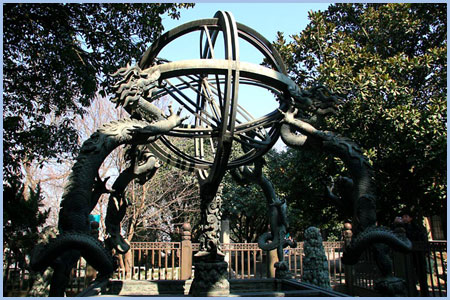Purple Mountain Observatory (Zijinshan Observatory)
It is said that your wish will come true when you make a bow to god while the meteor is shooting across the sky. Whether it is superstition or not, it shows to some extent the importance of celestial phenomena in people's minds. Then, does this saying stir up curiosity about Chinese astronomy? The Purple Mountain Observatory may give you a satisfactory answer.

Purple Mountain Observatory is located in the Zhong Mountain (Purple Mountain) Scenic Area in the east suburb of Nanjing City. Seen from afar, the white domed buildings are shining brightly in the sun. Finished in 1934, it is the earliest and one of the most famous observatories in China. Of milestone significance, it symbolizes the threshold of Chinese modern astronomy.
At the beginning, the observatory enjoyed a great reputation for its splendid architectures, rare apparatus and abundant books. The 60-centimeter-caliber reflecting telescope, the 20-centimeter-caliber refracting telescope (both made in Germany) and the meridian transit made by Swiss were almost the most advanced equipment of the time. And they are still housed in the observatory. Now, it is well equipped with modern facilities used for doing experiments and observing the sun, the moon, the planets, the fixed stars and satellites.
What's more, many ancient astronomical apparatus made of bronze are also displayed here, including Armillary Sphere, Simplified Armillary Sphere and Gnomon of the Ming Dynasty (1368-1644) and Celestial Globe and Altazimuth of the Qing Dynasty (1644-1911).
Armillary Sphere, designed by Zhang Heng in the Eastern Han Dynasty (25-220), was used to determine the position of the stars. It is not only an astronomical apparatus but also an exquisite craftwork. Its four poles were engraved with entwining dragons and the four sides of the base were cast with special flowers and animals. The one we can see today is a mimic of the Ming Dynasty. Simplified Armillary Sphere, as its name indicates, is the amelioration of Armillary Sphere. It is designed by astronomer Guo Shoujing in the Yuan Dynasty (1271-1368). The precision of determination and the convenience of operation were both improved. Gnomon, having a history of more than 3000 years, was used to measure the shadow of the sun and determine the solar terms and number of days of a year. China is the first country to know that there are 365.25 days in a year.
Great achievements have been made in the observatory. Successively, more than 30 new variable stars and numbers of asteroids have been discovered, among which 100 asteroids have been numbered by the International Minor Planet Center. In addition, four comets were also discovered. The Ge Wang Comet was the first comet named with the surname of a Chinese discoverer. Besides which, the observatory contributed a lot in applications studies. It has successively established extensive links with other astronomical institutions at home and abroad.
|

